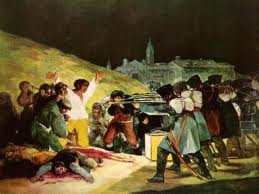Romanticism: Francisco de Goya
Francisco Goya is one of Spain's most famous painters and is still highly celebrated today. His style fits into the genre of Romanticism, which is especially present in his paintings of the Spanish Royal family.
However, one cannot deny that his later works contained aspects of both the political and personal issues present in Goya's life. Goya experienced the ups and downs of painting during his career, from being the most popular court painter in Spain, to being a deaf recluse in the Quinta del Sordo, in Madrid.
Francisco Goya (1746-1828)

Francisco Goya was born in Fuendetodos, Aragon, in Spain, yet moved to Zaragoza shortly afterwards. He then studied with many artists as an apprentice. Firstly with José Luzan when Goya was only fourteen.
After this, Goya moved to study in Madrid with a painter revered by the Spanish Royal Family, Anton Raphael Mengs. He then moved to Rome, painting frescoes in churches and entering art competitions. Francisco Goya also studied with the Spanish painter Francisco Bayeu y Subías, whose sister he later married. During this period, Goya developed his most famous style.
In 1789, Francisco Goya became an official Court painter and proceeded in painting several pictures of the Spanish Royal family. Three years later, Francisco Goya suffered a terrible illness which left him deaf. This incident affected Francisco Goya severely and led him to begin producing much darker paintings and etchings.
'Los Caprichos' (The Whims) were a series of experimental etchings, produced by Francisco Goya in 1799, which depicted many satirical scenes, especially relating to the Spanish clergy and nobility.
The most famous of these etchings is No.43 'The Sleep of Reason Produces Monsters' (El sueño de la razón produce monstruos). The Museo del Prado, in Madrid, now owns 'Los Caprichos'.
Between 1810 and 1820, Francisco Goya produced another series of images, this time prints, entitled 'Los desastres de la guerra' (The Disasters of War). These prints were extremely gruesome and showed many images of death and destruction. This set of prints were created by Francisco Goya as a protest against the violence during the uprising of the 2nd May 1808, or Dos de Mayo 1808. Goya then painted two paintings about these events, known as 'El dos de mayo de 1808 en Madrid' (The 2nd of May of 1808 in Madrid) and 'El tres de mayo de 1808 en Madrid' (The 3rd of May of 1808 in Madrid).

The 2nd May, or Dos de Mayo, is an extremely important day in Spanish culture as it marks the day that the Spanish began their uprising against the occupation of Madrid by Napoleon. Today, this date is celebrated with a celebration in Madrid, Las Fiestas del Dos de Mayo. Despite the horrific subject matter, the prints had some amusing names such as 'The Same' (Lo mismo) and 'What good is a cup?' (¿De qué sirve una taza?).
During the later years of his life, Francisco Goya became increasingly introvert, spending all his time in his villa, the Quinta del Sordo. It was here, from 1819 to 1823, that Goya painted The Black Paintings (Las pinturas negras), a series of dark paintings, which Goya painted as frescoes directly onto the inside walls of the house.
One of the most famous of this series of paintings is 'Saturn Devouring his Son' (El Saturno). Today, these paintings can be viewed in the Museo del Prado in Madrid, where they are on permanent display.
Francisco Goya has been an influence for many artists. His work was used extensively in the play 'El sueño de la razón' by Antonio Buero Vallejo, written in 1969. Buero Vallejo used Goya's lfe and work as a subtle tool to express his feelings about the dictatorship of Francisco Franco of the time. Buero Vallejo, who originally trained as a painter, also wrote the play to offer his own interpretation on the works of Francisco Goya.
